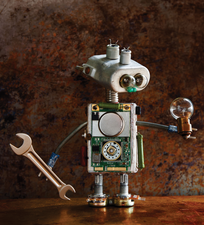An ASCII puzzle for an escape room challenge
Jail Break

© Lead Image © besjunior; 123rf.com
A digital puzzle presents a challenge for young people in an escape room.
A teacher recently asked me to help create a couple of puzzles for an escape room she was designing for her classes. Escape rooms have a number of interpretations, themes, and implementations but ultimately comprise a series of puzzles designed around a theme. Solving one puzzle provides a clue to something else. Sometimes a puzzle is just an off-the-shelf combination lock, and as you play other parts of the game, you'll discover the combination (or three numbers that you can try as the combination).
One puzzle I designed starts with a number on a seven-segment display (see the "Seven-Segment Display" box), a bundle of leads clipped onto two rows of electrical connections, and an unfinished set of notes. A previous adventurer has started to decode the puzzle and left notes for whoever might follow. The top set of connections is numbered 128, 64, 32, 16 , 8, 4, 2, and 1. The bottom set of connections isn't labeled, but each post has an associated LED, only a few of which are lit.
Theory of Operation
Built into the code of the display box, the secret word to be revealed is part of an Arduino program. The number displayed is the ASCII representation of the character currently being sought. Players must use clip leads to connect the numbers on the top to the active (lit) connections on the bottom so that the connected posts add up to the displayed number. A "check" post is tapped with an extra clip lead, and the display will either say CORRECT or NO.
[...]
Buy this article as PDF
(incl. VAT)
Buy Linux Magazine
Subscribe to our Linux Newsletters
Find Linux and Open Source Jobs
Subscribe to our ADMIN Newsletters
Support Our Work
Linux Magazine content is made possible with support from readers like you. Please consider contributing when you’ve found an article to be beneficial.

News
-
Two New Distros Adopt Enlightenment
MX Moksha and AV Linux 25 join ranks with Bodhi Linux and embrace the Enlightenment desktop.
-
Solus Linux 4.8 Removes Python 2
Solus Linux 4.8 has been released with the latest Linux kernel, updated desktops, and a key removal.
-
Zorin OS 18 Hits over a Million Downloads
If you doubt Linux isn't gaining popularity, you only have to look at Zorin OS's download numbers.
-
TUXEDO Computers Scraps Snapdragon X1E-Based Laptop
Due to issues with a Snapdragon CPU, TUXEDO Computers has cancelled its plans to release a laptop based on this elite hardware.
-
Debian Unleashes Debian Libre Live
Debian Libre Live keeps your machine free of proprietary software.
-
Valve Announces Pending Release of Steam Machine
Shout it to the heavens: Steam Machine, powered by Linux, is set to arrive in 2026.
-
Happy Birthday, ADMIN Magazine!
ADMIN is celebrating its 15th anniversary with issue #90.
-
Another Linux Malware Discovered
Russian hackers use Hyper-V to hide malware within Linux virtual machines.
-
TUXEDO Computers Announces a New InfinityBook
TUXEDO Computers is at it again with a new InfinityBook that will meet your professional and gaming needs.
-
SUSE Dives into the Agentic AI Pool
SUSE becomes the first open source company to adopt agentic AI with SUSE Enterprise Linux 16.

